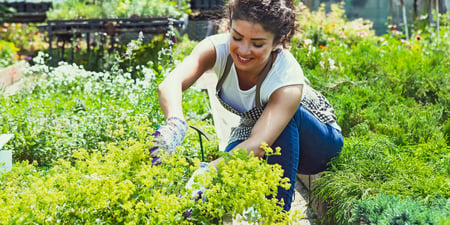Gardening With A Purpose – How Therapeutic Spaces Enhance Wellbeing

“The glory of gardening: hands in the dirt, head in the sun, heart with nature. To nurture a garden is to feed not just on the body, but the soul.” - Alfred Austin.
Green environments can do wonders for our body, mind and spirit. Simply taking a deep breath of fresh air, watching an insect feeding on a plant or feeling the prickly sensation of grass beneath your toes, has a profoundly positive impact on our physical and emotional well-being.
‘Therapeutic gardens,’ or horticulture therapy, involves the use of plant environments to facilitate interactions with nature and improve the mental and physical health of individuals or groups. According to disability expert and writer Charlotte Gerber[1], these purposefully crafted therapeutic spaces are gaining in popularity as a tool to assist patients with chronic illness and disability.
In an article for verywellhealth, Gerber explains that the therapeutic use of plants and garden-related activities was first introduced by psychiatrist Dr. Benjamin Rush in the 19th century, who reported the profound benefits that gardening offered his mental health patients. Today, therapeutic gardens are used in a variety of settings, such as rehabilitation facilities, nursing homes, hospitals, botanical gardens, nurseries, and prisons.
In this article, our attention is drawn to many of the evidence-based health benefits that gardens have on offer. These range from improvements in mental health to the development of skills, increased social interaction, and enhanced quality of life.
If you are considering using nature as therapy to create a therapeutic garden, there are specific criteria to consider:
-
Decide the main purpose of your garden - during the planning phase of the garden, the primary question you need to ask yourself is who the garden is being designed for. The needs of the individual or group who will be using the space should be considered before building and planning begins. For example, is the garden designed for an individual? What types of activities will be carried out in the space? Will the garden be created for a sensory, healing, or restorative experience?
-
Create a safe and accessible garden design - if the space is designed for an individual with a disability, ensuring that the paths and entrances are easily accessible is an important feature of the garden.
-
Consider the selection of plants - plants range in colours, textures, and fragrances. The selection of plants should enhance the therapeutic experience and therefore requires careful consideration and planning.
To explore the benefits of nature-based and other therapies book a free discovery call with our qualified practitioners today!
References
1. Charlotte Gerber. verywellhealth; 2024.
Disclaimer: This Content has been developed from our generous global community and is intended for informational purposes only. This Content is not, nor is it intended to be, a substitute for professional medical advice, diagnosis, or treatment and should never be relied upon. Further, the personal views and experiences published are expressly those of the author, and do not represent the views or endorsement of SoulAdvisor through the act of publication on our site.























